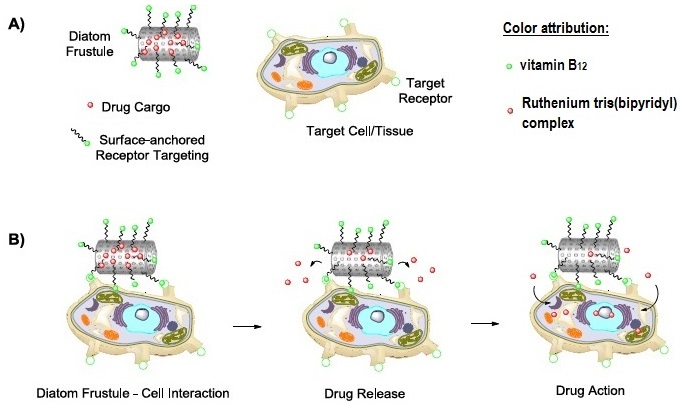Diatoms functionalized with Vitamin B12 as micro-shuttle for targeting delivery of water poor soluble Ruthenium complex
Over the past few years, an ever-increasing awareness of our environment has prompted us to find new, greener manufacturing processes for our products, and our medicines are no exception to this rule. Porous silica-based materials and nanoparticles are particularly attractive for drug-delivery applications due to the excellent biocompatibility, biodegradability, thermal stability and chemical inertness of the materials. In our work, bio-inspired materials are employed as a drug vector to target different sites of interest. However, instead of the typical synthetic nanoporous silica nanoparticles, the greener and more accessible diatoms, which offer excellent manufacturing support for a large variety of poorly soluble drugs, are used.To date, several studies have already been carried out on the potential of this material in the field of targeting drug delivery. In particular, Walker et al. reported the specific binding and uptake of B12-nanoparticles in Caco-2 cells from apical to basal chambers and showed that an increased density of vitamin B12 at the particle surface increased their uptake[1]. More recently, Losic et al. reported studies on diatoms functionalized with different compounds and used for the delivery of Indomethacin[2],[3] and Levoflaxin[4]. In the current study, we report the use of vitamin B12 for the surface functionalization of diatoms in order to achieve the specific targeting and delivery of a very cytotoxic ruthenium tris(bipyridyl) complex of poor water solubility. We showed that the release of the drug from B12 functionalized diatoms is achievable in different media which is very promising for further investigation. Currently in vitro experiments are ongoing to assess the efficiency of the concept.

Figure 1: Conceptual representation of the diatom frustules as cell-targeting/drug delivery capsules. A) Definition of components in diatom frustule delivery system and target cell. B) From left to right: receptor-mediated frustule-cell interaction; drug delivery following drug penetration or action at target site (drug action)
[1] G. J. Russell-Jones, L. Arthur, H. Walker, International Journal of Pharmaceutics, 1999, 2, 247–55.
[2] Moom Sinn Aw et al., Journal of Biomaterials Applications, 2012, 2, 163–174.
[3] Tushar Kumeria et al., Journal of Materials Chemistry B, 2013, 1, 6302–6311.
[4] R. B. Vasani et al., Journal of Materials Chemistry B, 2015, 3, 4325–4329.